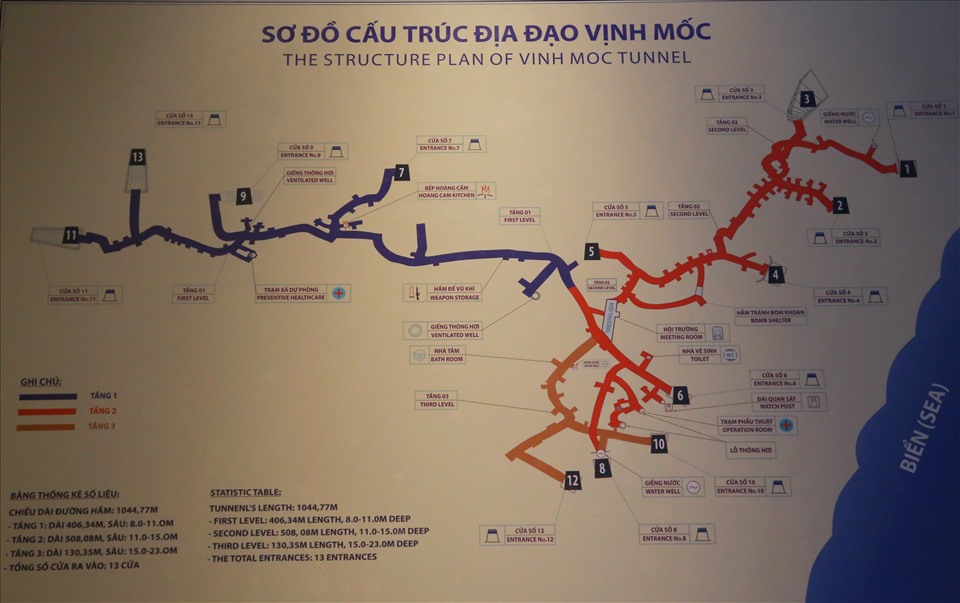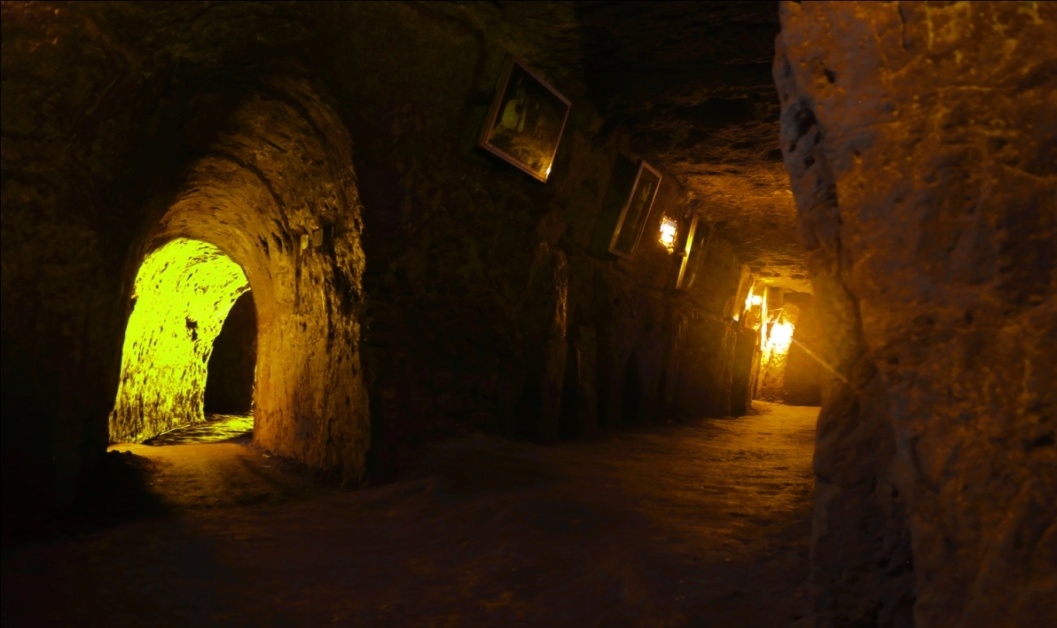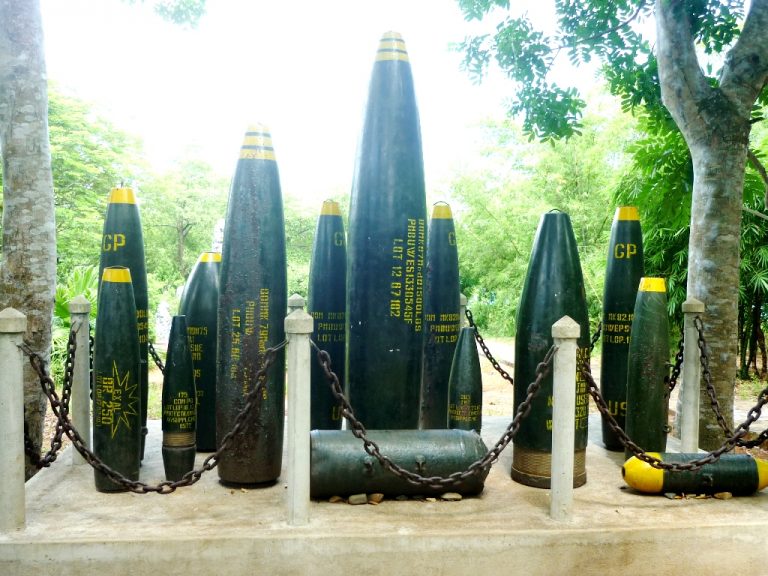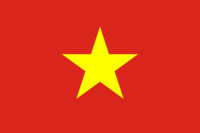Vịnh Mốc Tunnels
The Vịnh Mốc Tunnels, located in Vịnh Mốc village, Kim Thạch commune, Vĩnh Linh district, Quảng Trị province, Vietnam, is a military-civilian complex dating back to the Vietnam War. These tunnels were built by the Democratic Republic of Vietnam (North Vietnam) as a defensive measure against the attacks from the Republic of Vietnam (South Vietnam) and the United States. The tunnel system existed in the area north of the Bến Hải River and the Hiền Lương Bridge from 1965 to 1972.
History In the 1960s, the government of the Republic of Vietnam, under Ngô Đình Diệm, did not adhere to the 1954 Geneva Accords and failed to hold the scheduled general elections. Alongside their military operations against local uprisings in the South, the United States escalated tensions and engaged in clashes with the forces of the Democratic Republic of Vietnam along the Vĩnh Linh frontlines. In 1965, the United States initiated Operation Rolling Thunder to start a campaign of aerial bombardment in North Vietnam, with Vĩnh Linh as one of its primary targets.

During the years 1965 – 1972, Vĩnh Linh suffered continuous destruction, with over half a million tons of bombs dropped in the area. On average, each resident had to endure the impact of 7 tons of U.S. bombs.
Construction Process The first tunnels in Vietnam appeared in 1947 in the Phú Thọ Hòa region (now part of Tân Bình – Ho Chi Minh City). Then, between 1961 and 1965, extensive tunnel systems were developed in the Củ Chi area, spanning five communes. In late 1963, Trần Nam Trung, who was sent from the Central Committee of the Communist Party of Vietnam in South Vietnam to the North, visited the combat areas in Vĩnh Giang commune (Vĩnh Linh). After observing the terrain and geology in the region, he suggested that Vĩnh Linh should construct tunnels similar to those in Củ Chi. With the motto “Not one inch of land lost, not one village abandoned. Every village and commune is a fortress,” and through directives from the Vĩnh Linh Party Committee, Đôn Trưởng (Militia Company Commander) Lê Xuân Vy, who had just completed primary school education, quickly organized his unit and local residents to begin tunnel construction. The project commenced in early 1965 and was completed on February 18, 1966. Remarkably, Lê Xuân Vy, who led this project, had only completed primary school education at that time, and his most advanced tool was an old and worn-out compass. Today, Mr. Lê Xuân Vy is a retired lieutenant colonel at the age of 85, living in Đông Hà city, and he is blind due to injuries sustained during the war.

Structure To ensure the safety and convenience of hundreds of people living underground, numerous apartments were constructed on both sides of the tunnel. Each apartment was designed to accommodate three to four people. Within the tunnel system, there were three water wells, an assembly hall (with a capacity of 50 people), a clinic, a maternity ward, a surgical station, the Hoàng Cầm kitchen, a rice storage facility, and a telephone communication station.
Running along both sides of the main tunnel, which was about 12 to 15 meters below the surface, were smaller tunnels that served as living spaces for individual families. The tunnel system consisted of three levels: the first level, at a depth of 12 meters, was used for combat and temporary shelter. The second level, located 15 meters underground, served as living quarters and the headquarters for the Party Committee, the People’s Committee, and the Military Command. The third level, 23 meters deep, was used for storing supplies and weapons. Even at the deepest level, 23 meters below the surface, the tunnels remained above the sea level by up to 3 meters, ensuring normal activities even during the rainy season. The entire Vịnh Mốc tunnel system had 13 exits, including seven leading to the sea and six leading to the hills. Each tunnel exit had wooden supports to prevent collapse and was regularly reinforced to prevent erosion. The residents rarely left the tunnels, only venturing outside when necessary and when it was safe.
Life Underground Life in the tunnels lacked natural light, with high humidity in the winter and scorching heat in the summer. Poor sanitation conditions led to widespread parasitic infections, skin issues, and bone and eye-related health problems among the residents. Daily life in the confined spaces of the tunnels included studying, socializing, entertainment, caring for children, and more, all within the narrow 1.8-meter-wide tunnel.
To maintain their safety and the continuity of their lineage, families, clans, and the residents of Vịnh Mốc had to live in different tunnels. During their time living underground in Vĩnh Linh in general, 60 children were born, with 17 of them being born in the Vịnh Mốc tunnels. The tunnels served as homes for people during the most intense years of the war, with up to approximately 1,200 people living there. Over nearly 2,000 days and nights, not a single person was injured in the tunnels, and 17 babies were born, underscoring the value and significance of the Vịnh Mốc tunnels. Many tunnels were created as maternity rooms and nurseries for children.

Casualties In the harsh reality of wartime, many tunnel systems were not sturdy enough to meet the requirements of providing safe shelter and combat for the civilian population in the border region. There were significant casualties due to structural failures. For example, on February 26, 1967, the Đơn Duệ tunnel (Vĩnh Hoà) was destroyed by U.S. bombs, resulting in four deaths. On June 20, 1967, the Tân Lý tunnel (in Vĩnh Quang) collapsed, causing 61 casualties. On July 27, 1967, the Xóm Bợc tunnel (in Vĩnh Thạch) collapsed, resulting in 22 deaths, and the Bình Minh tunnel (in Vĩnh Hiền) collapsed on September 10, 1967, leading to 39 deaths. Drawing lessons from these incidents, the Vịnh Mốc tunnels were constructed with greater durability and practicality, preventing casualties during the war.
Tourist Attraction The Vịnh Mốc Tunnels are part of the former non-military tourist area from the Vietnam War and have been recognized as a historical site in Vietnam. The Vịnh Mốc Tunnels museum officially opened its doors to visitors in 1995 and has since attracted a large number of tourists.
Visitors to the tunnels can explore the underground world that played a significant role in the history of Vietnam. The site offers insights into the resilience and resourcefulness of the Vietnamese people during wartime, showcasing their ability to adapt and survive in challenging conditions. The Vịnh Mốc Tunnels stand as a testament to the indomitable spirit of the Vietnamese people and their determination to protect their homeland.
Come and discover the Vịnh Mốc Tunnels, a place steeped in history and an integral part of Quảng Trị’s heritage. Witness the remnants of the past and learn about the incredible events that unfolded here during the Vietnam War.

